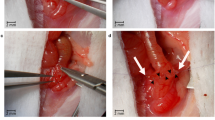Abstract
The pathophysiology of wound healing in the bowel wall suggests that collagen and matrix metalloproteinases (MMPs) have an important role in the changes of the bowel wall seen in several colonic diseases. Several recent studies suggest that disturbances of the collagen texture and the extracellular matrix (ECM) metabolism are major factors leading to the onset of diverticular disease. Changes of the ECM also play a role in the development of inflammatory bowel diseases. Regarding the permanent remodeling of the bowel wall, any imbalance of the ECM could support the onset of chronic inflammation and the development of fistula formation, such as that seen in patients with Crohn’s disease. Disturbances of the ECM play a role in the pathogenesis of anastomotic leakage after large bowel surgery and suggest the presence of a genetically defined risk population with disturbed wound healing mechanisms. This concept could explain the well known situation where an anastomotic breakdown is observed, despite the absence of other known risk factors and after a technically correct anastomosis.
Similar content being viewed by others
References
Fleischmajer R, Perlish JS, Burgeson RE, Shaikh-Bahai F, Timpl R (1990) Type I and type III collagen interactions during fibrillogenesis. Ann N Y Acad Sci 580(1):161–175
Sommerville RP, Oblander SA, Apte SS (2003) Matrix metalloproteinases: old dogs with new tricks. Genome Biol 4(6):216–222
Painter NS, Truelove SC, Ardran GM, Tuckey M (1965) Segmentation and the localization of intraluminal pressures in the human colon, with special reference to the pathogenesis of colonic diverticula. Gastroenterology 49:169–177
Schoetz DJ Jr (1999) Diverticular disease of the colon: a century-old problem. Dis Colon Rectum 42(6):703–709
Whiteway J, Morson BC (1985) Elastosis in diverticular disease of the sigmoid colon. Gut 26(3):258–266
Watters DAK, Smith AN, Eastwood MA, Anderson KC, Elton RA, Mugerwa JW (1985) Mechanical properties of the colon: comparison of the features of the African and European colon in vitro. Gut 26(4):384–392
Wess L, Eastwood MA, Wess TJ, Busuttil A, Miller A (1995) Cross linking of collagen is increased in colonic diverticulosis. Gut 37(1):91–94
Hoffmann P, Layer P (1995) Pathogenesis and pathophysiology of sigmoid diverticulitis (in German). Chirurg 66(12):1169–1172
Stumpf M, Cao W, Klinge U, Klosterhalfen B, Kasperk R, Schumpelick V (2001) Increased distribution of collagen type III and reduced expression of matrix metalloproteinase 1 in patients with diverticular disease. Int J Colorectal Dis 16(5):271–275
Parra-Blanco A (2006) Colonic diverticular disease: pathophysiology and clinical picture. Digestion 73(Suppl 1):47–57
Okabe N (2001) The pathogenesis of Crohn’s disease. Digestion 63(Suppl 1):52–59
Brignola C, Belloli C, Ardizzone S, Astegiano M, Cottone M, Trallori G (2000) The relationship between heritability and smoking habits in Crohn’s disease. Italian Cooperative Study Group. Am J Gastroenterol 95(11):3171–3175
Jorgensen LN, Kallehave F, Christensen E, Siana JE, Gottrup F (1998) Less collagen production in smokers. Br J Surg 123(4):450–455
Alexander AC, Irving MH (1990) Accumulation and pepsin solubility of collagens in the bowel of patients with Crohn’s disease. Dis Colon Rectum 33(11):956–962
Stallmach A, Schuppan D, Riese HH, Metthes H, Riecken EO (1992) Increased collagen type III synthesis by fibroblasts isolated from strictures of patients with Crohn’s disease. Gastroenterology 102(6):1920–1929
Stumpf M, Cao W, Klinge U, Klosterhalfen B, Junge K, Krones CJ, Schumpelick V (2005) Reduced expression of collagen type I and increased expression of matrix metalloproteinases 1 in patients with Crohn’s Disease. J Invest Surg 18(1):33–38
Kjeldsen J, Schaffalitzky de Muckadell OB, Junker P (1995) Seromarkers of collagen I and III metabolism in active Crohn’s disease. Relation to disease activity and response to therapy. Gut 37(6):805–810
Louis E, Ribbens C, Godon A, Franchimont D, De Groote D, Hardy N, Boniver J, Belaiche J, Malaise M (2000) Increased production of matrix metalloproteinase-3 and tissue inhibitor of metalloproteinase-1 by inflamed mucosa in inflammatory bowel disease. Clin Exp Immunol 120(2):241–246
von Lampe B, Barthel B, Coupland SE, Riecken EO, Rosewicz S (2000) Differential expression of matrix metalloproteinases and their tissue inhibitors in colon mucosa of patients with inflammatory bowel disease. Gut 47(1):63–73
McKaig BC, McWilliams D, Watson SA, Mahida YR (2003) Expression and regulation of tissue inhibitor of metalloproteinase-1 and matrix metalloproteinases by intestinal myofibroblasts in inflammatory bowel disease. Am J Pathol 162(4):1355–1360
Matthiessen P, Hallbook O, Rutegard J, Sjjodahl R (2006) Population-based study of risk factors for postoperative death after anterior resection of the rectum. Br J Surg 93(4):498–503
Alves A, Panis Y, Trancart D, Regimbeau JM, Pocard M, Valleur P (2002) Factors associated with clinically significant anastomotic leakage after large bowel resection: multivariate analysis of 707 patients. World J Surg 26(4):499–502
Stumpf M, Klinge U, Wilms A, Zabrocki R, Rosch R, Junge K, Krones CJ, Schumpelick V (2005) Changes of the extracellular matrix as a risk factor for anastomotic leakage after large bowel surgery. Surgery 137(2):229–234
Baker EA, Leaper DJ (2003) The plasminogen activator and matrix metalloproteinase system in colorectal cancer: relationship to tumor pathology. Eur J Cancer 39:981–988
Di Cholandrea T, Wang L, Wille J, D’Armiento J, Chada KK (1998) Epidermal expression of collagenase delays wound-healing in transgenic mice. J Invest Dermatol 111(6):1029–1033
Stumpf M, Cao W, Klinge U, Klosterhalfen B, Kasperk R, Schumpelick V (2002) Collagen distribution and expression of matrix metalloproteinases 1 and 13 in patients with anastomotic leakage after large-bowel surgery. Langenbecks Arch Surg 386(7):502–506
Stumpf M, Klinge U, Mertens PR (2004) Anastomotic leakage in the gastrointestinal tract-repair and prognosis (in German). Chirurg 75(11):1056–1062
Author information
Authors and Affiliations
Corresponding author
Rights and permissions
About this article
Cite this article
Stumpf, M., Krones, C.J., Klinge, U. et al. Collagen in colon disease. Hernia 10, 498–501 (2006). https://doi.org/10.1007/s10029-006-0149-4
Published:
Issue Date:
DOI: https://doi.org/10.1007/s10029-006-0149-4




